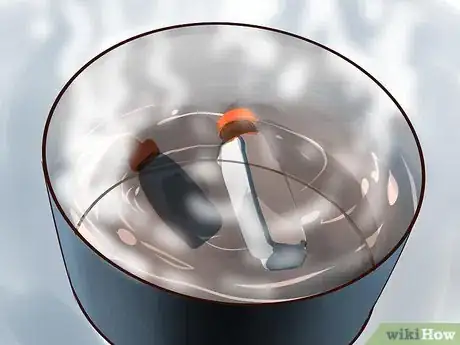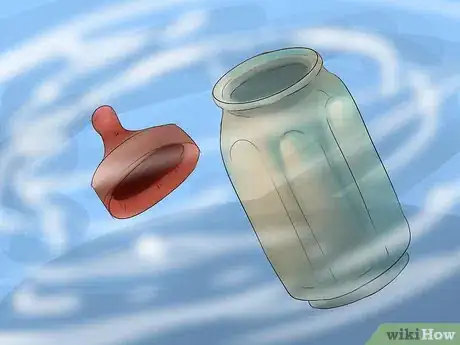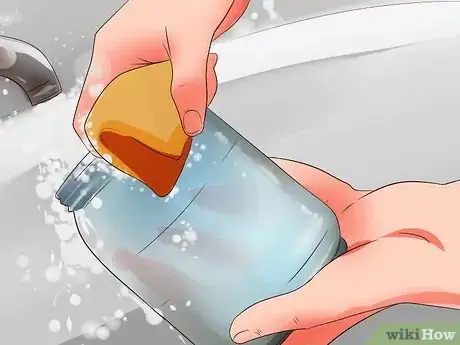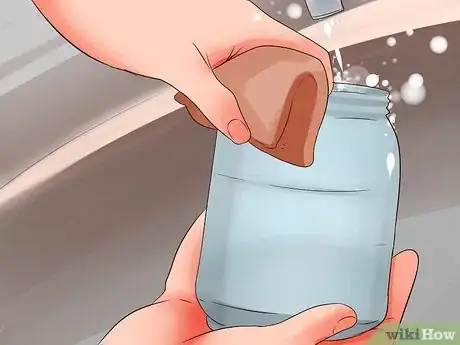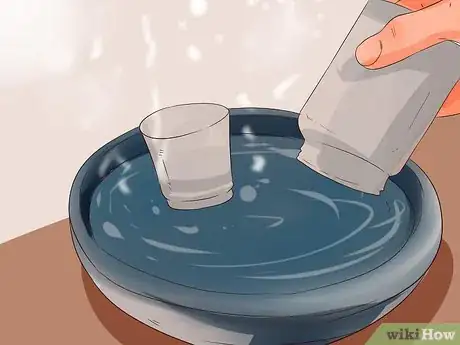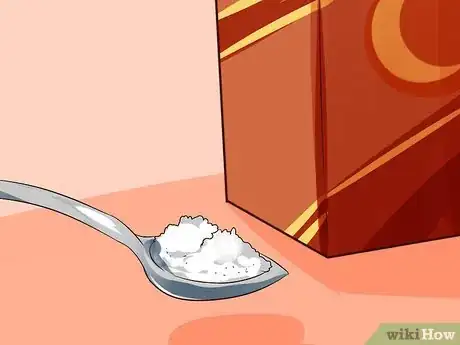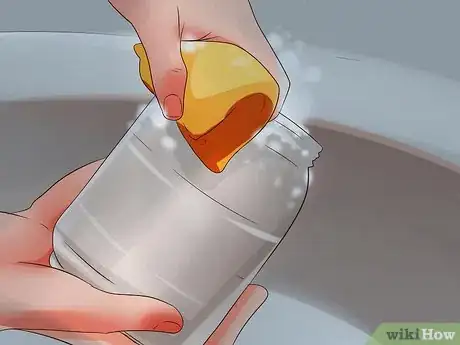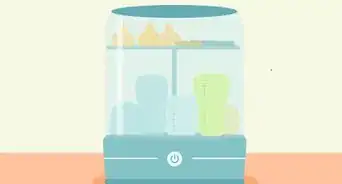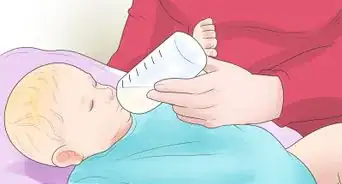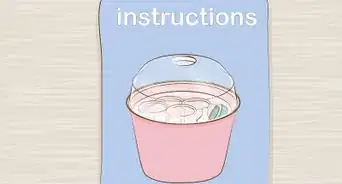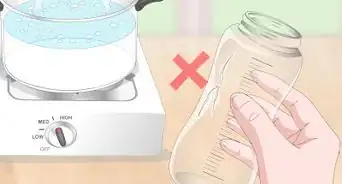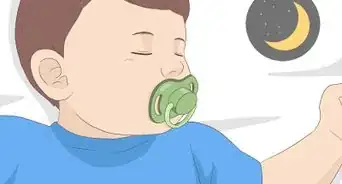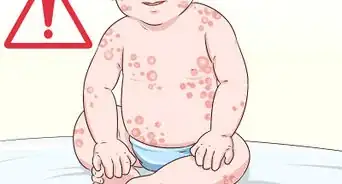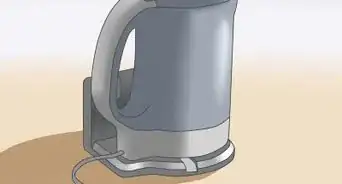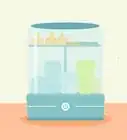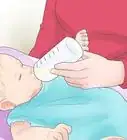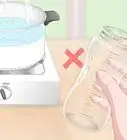This article was co-authored by Mor Levy Volner, IBCLC, RDN. Mor Levy Volner is an International Board Certified Lactation Consultant based in Southern California. She earned a BS in Clinical Nutrition from the University of California, Davis in 2009 and finished her Lactation Consultant course from the University of California, San Diego Extension Program in 2013, which included 300 hours of lactation consulting experience from Kaiser Permanente. She also has an MS in Dietetics/Nutrition from the California State University - Northridge in 2014.
This article has been viewed 53,325 times.
Sterilizing baby equipment, especially glass baby bottles, removes germs and provides your baby with a clean eating surface. Glass baby bottles can be sterilized and deep cleaned more easily than other types of baby bottles, including plastic or disposable bottles.[1]
Steps
Knowing When to Sterilize
-
1Sterilize the glass bottle before you use it for the first time. Sterilizing before the first use is incredibly important, as it removes all the grime and germs from the packaging and from anyone who touched the bottle before you purchased it.
- You should sterilize every part of the bottle, including the nipple and attachment rings.
-
2Make sure to sterilize the glass bottle after every use. You should do this while your child is very young, as her immune system will be weaker than when she is older. As your child grows, you can gradually switch to sterilizing the bottles after every few uses during the first six months of your baby's life.Advertisement
-
3Rinse the bottle before sterilizing it. Sterilizing a baby bottle isn't effective if the bottle isn't clean first. Always rinse and wash baby bottles with baby-safe dish soap before sterilizing them.
- Be sure to wash your hands before touching a baby bottle to limit the amount of dirt and germs that touch the feeding tools.
-
4Clean the bottles by hand when your baby gets older. After your baby reaches six months of age, your baby's immune system is stronger, and cleaning the bottle by hand with dish soap or in the dishwasher is sufficient.
Trying Different Sterilizing Techniques
-
1Boil the bottle to sterilize it. To sterilize by boiling, place the baby bottles and all other feeding equipment in a large saucepan and cover them with water. Cover the pot with a lid and bring the water to a boil—keep the water boiling for five minutes.
- Leave the lid on as the water cools, then drain the water and store the equipment in the refrigerator until needed.
-
2Try using baking soda. To sterilize the bottles with baking soda, fill a large pot with water and three tablespoons of baking soda. Add the bottles and accessories to the pot. Bring the water to a boil and allow the water to boil for at least three minutes. Once the water has cooled, remove the bottles and allow them to air dry before use.
- Baking soda can be incredibly useful for more worn baby bottles, or if you want an extra boost to the sterilization.
-
3Sterilize your bottles in the dishwasher. To sterilize the bottles in the dishwasher, simply put the glass baby bottles on the top rack of the washer and put the accessories in a basket on the top rack.[2] Run a hot rinse cycle and allow the bottles to dry completely either in the dishwasher or on the counter.[3]
-
4Use a microwave sterilizer to rid glass bottles of germs.[4] Special microwave baby bottle sterilizers can be purchased at any baby store. Follow the instructions on the sterilizer's package:
- They typically require you to put a small amount of water in the bottom of the device, place the bottle inside, and microwave on high.
- The steam and hot water from the microwave remove germs and bacteria from the bottle.
Expert Q&A
Did you know you can get expert answers for this article?
Unlock expert answers by supporting wikiHow
-
QuestionHow do I sterilize baby bottles naturally?
 Mor Levy Volner, IBCLC, RDNMor Levy Volner is an International Board Certified Lactation Consultant based in Southern California. She earned a BS in Clinical Nutrition from the University of California, Davis in 2009 and finished her Lactation Consultant course from the University of California, San Diego Extension Program in 2013, which included 300 hours of lactation consulting experience from Kaiser Permanente. She also has an MS in Dietetics/Nutrition from the California State University - Northridge in 2014.
Mor Levy Volner, IBCLC, RDNMor Levy Volner is an International Board Certified Lactation Consultant based in Southern California. She earned a BS in Clinical Nutrition from the University of California, Davis in 2009 and finished her Lactation Consultant course from the University of California, San Diego Extension Program in 2013, which included 300 hours of lactation consulting experience from Kaiser Permanente. She also has an MS in Dietetics/Nutrition from the California State University - Northridge in 2014.
International Board Certified Lactation Consultant
-
QuestionHow can I sterilize glass bottles in the microwave?
 Mor Levy Volner, IBCLC, RDNMor Levy Volner is an International Board Certified Lactation Consultant based in Southern California. She earned a BS in Clinical Nutrition from the University of California, Davis in 2009 and finished her Lactation Consultant course from the University of California, San Diego Extension Program in 2013, which included 300 hours of lactation consulting experience from Kaiser Permanente. She also has an MS in Dietetics/Nutrition from the California State University - Northridge in 2014.
Mor Levy Volner, IBCLC, RDNMor Levy Volner is an International Board Certified Lactation Consultant based in Southern California. She earned a BS in Clinical Nutrition from the University of California, Davis in 2009 and finished her Lactation Consultant course from the University of California, San Diego Extension Program in 2013, which included 300 hours of lactation consulting experience from Kaiser Permanente. She also has an MS in Dietetics/Nutrition from the California State University - Northridge in 2014.
International Board Certified Lactation Consultant
References
- ↑ http://www.webmd.com/parenting/baby/choosing-a-bottle
- ↑ Mor Levy Volner, IBCLC, RDN. International Board Certified Lactation Consultant. Expert Interview. 5 May 2020.
- ↑ http://thetoughcookie.com/2013/09/15/sterilize-glass-jars-and-bottles/
- ↑ Mor Levy Volner, IBCLC, RDN. International Board Certified Lactation Consultant. Expert Interview. 5 May 2020.
